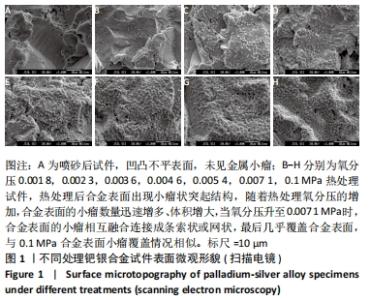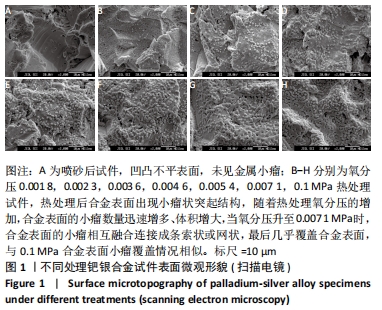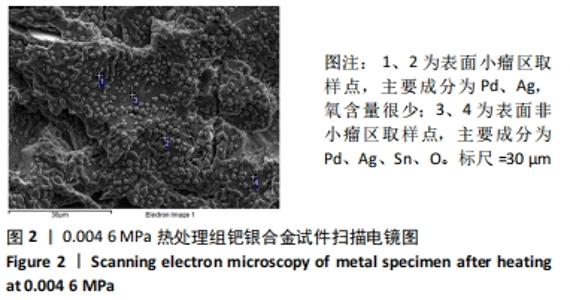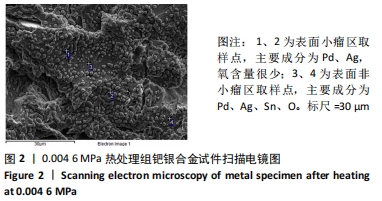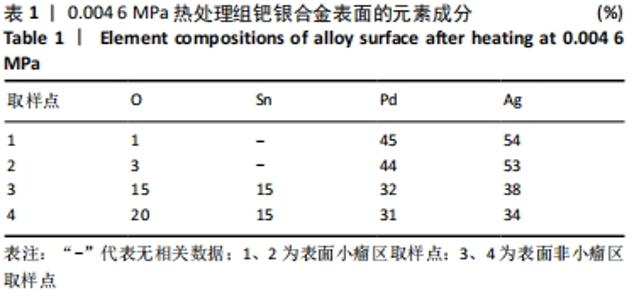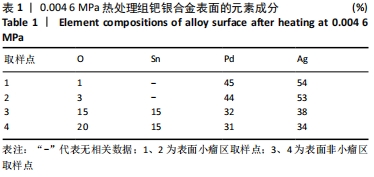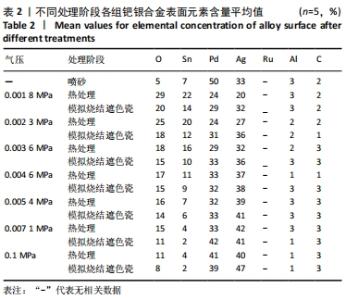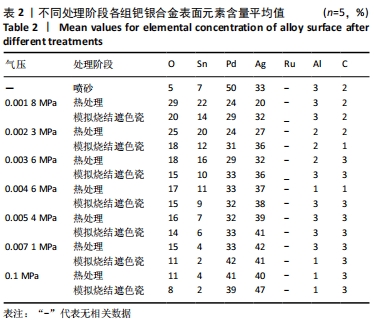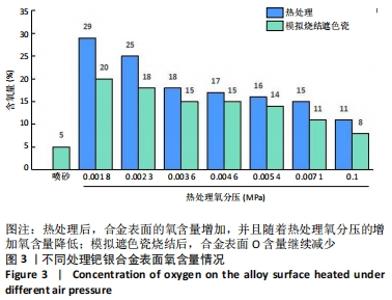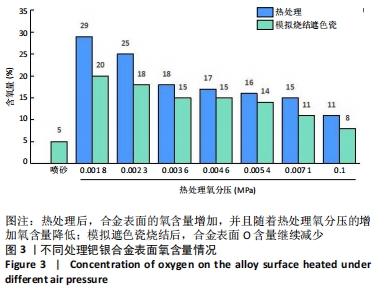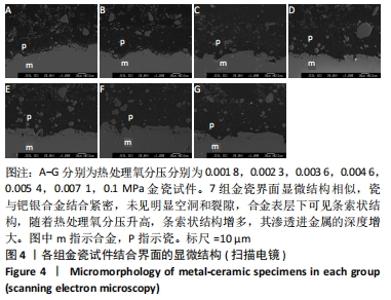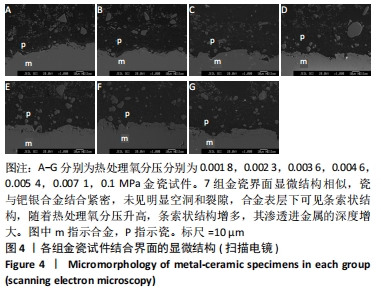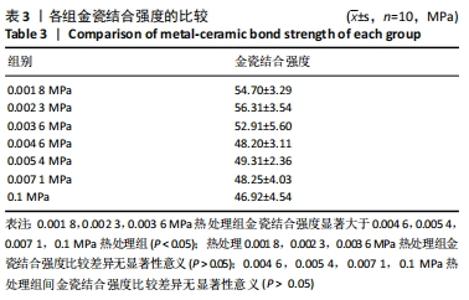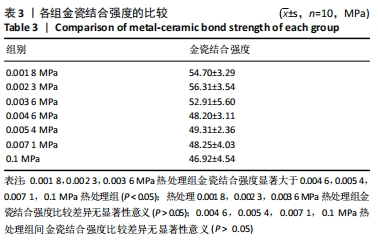[1] CARR AB, BRANTLEY WA. New high-palladium casting alloys: 1. Overview and initial studies. Int J Prosthodont. 1991;4(3):265-275.
[2] ROBERTS HW, BERZINS DW, MOORE BK, et al. Metal-ceramic alloys in dentistry: a review. J Prosthodont. 2009;18(2):188-194.
[3] CHEN X, ZHANG Y, ZHOU J, et al. Effect of different surface treatments and retainer designs on the retention of posterior Pd-Ag porcelain-fused-to-metal resin-bonded fixed partial dentures. Exp Ther Med. 2018;15(2):2006-2014.
[4] 李博华,王永功,马欣,等.反复熔铸对钯银烤瓷合金金瓷结合性能的影响[J].医药论坛杂志,2019,40(11):6-9.
[5] LI BH, YE JT, LIAO JK, et al. Effect of pretreatments on the metal–ceramic bonding strength of a Pd–Ag alloy. J Dent. 2014;42:319-328.
[6] 孙启,周亚男,董鑫,等.激光选区熔化钴铬烤瓷合金金瓷结合界面的特性[J].中国组织工程研究,2021,25(4):521-525.
[7] 叶剑涛,李博华,李洁银,等.两种喷砂粒度对钯银合金金瓷结合强度的影响[J].中华口腔医学研究杂志(电子版),2015,9(1):37-43.
[8] AL-HELOU H, SWED E. Effect of metal type and surface treatment on shear bond strength of resin cement (in vitro study). J Indian Prosthodont Soc. 2016;16(1):49-52.
[9] YOO SY, KIM SK, HEO SJ, et al. Effects of Bonding Agents on Metal-Ceramic Bond Strength of Co-Cr Alloys Fabricated by Selective Laser Melting. Materials (Basel). 2020;13(19):4322.
[10] HONG JT, SHIN SY. A comparative study on the bond strength of porcelain to the millingable Pd-Ag alloy. J Adv Prosthodont. 2014;6(5): 372-378.
[11] 吕静,谈飞,袁慕洁,等.电子束蒸镀纳米二氧化硅涂层对钛瓷结合强度影响的研究[J].口腔颌面修复学杂志,2020,21(3):141-147.
[12] LU Y, ZHAO C, REN L, et al. Preliminary assessment of metal-porcelain bonding strength of CoCrW alloy after 3wt.% Cu addition. Mater Sci Eng C Mater Biol Appl. 2016;63:37-45.
[13] ANTANASOVA M, KOCJAN A, KOVAC J, et al. Influence of thermo-mechanical cycling on porcelain bonding to cobalt–chromium and titanium dental alloys fabricated by casting, milling, and selective laser melting. J Prosthodont Res. 2018;62(2):184-194.
[14] LI J, YE X, LI B, et al. Effect of oxidation heat treatment on the bond strength between a ceramic and cast and milled cobalt-chromium alloys. Eur J Oral Sci. 2015;123(4):297-304.
[15] YAN X, XU YX, WU Y, et al. Effects of heat treatment on metal-ceramic combination of selective-laser-melted cobalt-chromium alloy. J Prosthet Dent. 2018;120(2):319.e1-319.e6.
[16] ANTANASOVA M, KOCJAN A, HOCEVAR M, et al. Influence of surface airborne-particle abrasion and bonding agent application on porcelain bonding to titanium dental alloys fabricated by milling and by selective laser melting. J Prosthet Dent. 2020;123(3):491-499.
[17] LI JY, LI RN, CHANG SH, et al. Effect of heating palladium-silver alloys on ceramic bond strength. J Prosthet Dent. 2015;114(5):715-724.
[18] JOHNSON T, VAN NOORT R, STOKES CW. Surface analysis of porcelain fused to metal systems. Dent Mater. 2006;22(4):330-337.
[19] MACKERT JJ, RINGLE RD, FAIRHURST CW. High-temperature behavior of a Pd-Ag alloy for porcelain. J Dent Res. 1983;62(12):1229-1235.
[20] LIMKOOL P, SUMII T. Study of a Pd-Ag-Sb system alloy for metal-ceramics. Bull Tokyo Dent Coll. 1995;36(3):103-114.
[21] SCOLARO JM, PEREIRA JR, DO VALLE AL, et al. Comparative study of ceramic-to-metal bonding. Braz Dent J. 2007;18(3):240-243.
[22] SHIMIZU T, GOTO S, OGURA H. Effects of Sn, Ga, and In additives on properties of Ag-Pd-Au-Cu alloy for ultra-low fusing ceramics. Dent Mater J. 2001;20(4):286-304.
[23] 叶剑涛,李博华,李洁银,等.两种喷砂粒度对钯银合金金瓷结合强度的影响[J].中华口腔医学研究杂志(电子版),2015,9(1):37-43.
[24] ISO 9693:2019. Dentistry-Compatibility testing for metal-ceramic and ceramic-ceramic systems. Geneva, Switzerland: International Organization for Standardization, 2019.
[25] SCHWEITZER DM, GOLDSTEIN GR, RICCI JL, et al. Comparison of Bond Strength of a Pressed Ceramic Fused to Metal versus Feldspathic Porcelain Fused to Metal. J Prosthodont. 2005;14(4):239-247.
[26] VIENNOT S, LISSAC M, MALQUARTI G, et al. Influence of casting procedures on the corrosion resistance of clinical dental alloys containing palladium. Acta Biomater. 2006;2(3):321-330.
[27] WANG CS, CHENKK, TAJIMA K, et al. Effects of sandblasting media and steam cleaning on bond strength of titanium-porcelain. Dent Mater J. 2010;29(4):381-391.
[28] ASAKURA M, KOMINAMI Y, HAYASHI T, et al. The effect of zinc levels in a gold-based alloy on porcelain-metal bonding. Dent Mater. 2012;28(5): e35-41.
[29] RATHI S, PARKASH H, CHITTARANJAN B, et al. Oxidation heat treatment affecting metal-ceramic bonding. Indian J Dent Res. 2011;22(6):877-878.
[30] 李博华,叶剑涛,王永功,等.除气和预氧化对钯银合金金瓷结合强度的影响[J].实用口腔医学杂志,2015,31(2):200-204.
[31] 伊哲,郝玉全,吴琳,等.钯银合金与钴铬合金的机械性能及金瓷结合强度的比较研究[J].中国实用口腔科杂志,2012,5(6):354-357.
|
